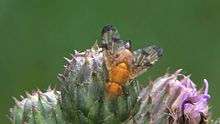Xyphosia miliaria
| Xyphosia miliaria | |
|---|---|
| | |
| Xyphosia miliaria, female | |
| Scientific classification | |
| Kingdom: | Animalia |
| Phylum: | Arthropoda |
| Class: | Insecta |
| Order: | Diptera |
| Family: | Tephritidae |
| Genus: | Xyphosia |
| Species: | X. miliaria |
| Binomial name | |
| Xyphosia miliaria Schrank, 1781 | |
| Synonyms | |
| |
Xyphosia miliaria is a species of tephritid or fruit flies in the family Tephritidae.
Description

Xyphosia miliaria may have a body length of 5 to 8 mm and a wingspan of 15 to 18 mm. The thorax and the abdomen are yellowish, sparsely covered with long bristles and the mesonotum is longer than wide. The abdomen is round in males, elongated in the females and the females bear at the end of the abdomen a dark brown, pointed ovipositor. The large compound eyes are orange-red. The wings are decorated with distinctive dark apical and transversal drawings. The adults fly from May to September feeding on nectar and pollen of various flowering plants. Larvae develop on buds of thistles (Carduus nutans, Cirsium arvense, Cirsium palustre, Cirsium eriophorum).
Distribution
This species is present in most of Europe, in East Palearctic ecozone and in the Near East.
Habitat
This species occurs in wet meadows, in parks and gardens with the presence of thistles.